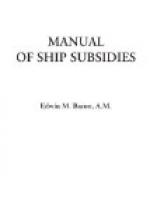An English-built full-fledged steamer made the next venture, but not until a decade after the Savannah’s feat. This was the Curacoa, 350 tons, and one hundred horsepower, built for Hollanders, and sent out from England in 1829. The third was by a Canada-built ship—the Royal William, 500 or more tons, and eighty horsepower, with English-built engines, launched at Three Rivers. She crossed from Quebec to Gravesend in 1833. The next were the convincing tests that settled for the Admiralty the question of transatlantic mail service by steamship instead of sailing packet. These were the voyages out and back of the Sirius and the Great Western in 1838.
The Sirius had been in service between London and Cork. The Great Western was new, and was the first steamship to be specially constructed for the trade between England and the United States. Both were much larger than their three predecessors in steam transatlantic ventures, and better equipped. The Sirius started out with ninety-four passengers, on the fourth of April, 1838, and reached New York on the twenty-first, a passage of seventeen days. The Great Western, also with a full complement of passengers, left three days after the Sirius, sailing from Bristol, and swung into New York harbor on the twenty-third, making her passage in two days’ less time than her rival. Both were hailed in New York with “immense acclamation.” They sailed on their homeward voyage in May, six days apart, and made the return passage respectively in sixteen and fourteen days. The Great Western on her second homeward voyage beat all records, making the run in twelve days and fourteen hours, and “bringing with her the advices of the fastest American sailing-ships which had started from New York long before her."[U] This clinched the matter. The Admiralty now invited tenders for the transatlantic mail service, by steam, between Liverpool, Halifax, and New York.
The first call for tenders was made in October, 1838. The St. George’s Packet Company, owners of the Sirius, and the Great Western Steamship Company, owners of the Great Western, put in bids, the former offering a monthly service between Cork, Halifax, and New York for a yearly subsidy of sixty-five thousand pounds; the latter, a monthly service between Bristol, Halifax, and New York for forty-five thousand pounds a year.
Neither offer was accepted for the reason, as was stated, that a semimonthly service was desired.[V] Instead, private arrangements were made with Samuel Cunard and associates for a carriage between Liverpool, Halifax, Quebec, and Boston, twice a month, for a term of seven years, the subsidy to be sixty thousand pounds annually, less four thousand pounds for making only one voyage a month in the winter season.[W] The contract required Mr. Cunard and his associates to furnish five ocean steamships and two river steamers, the latter




